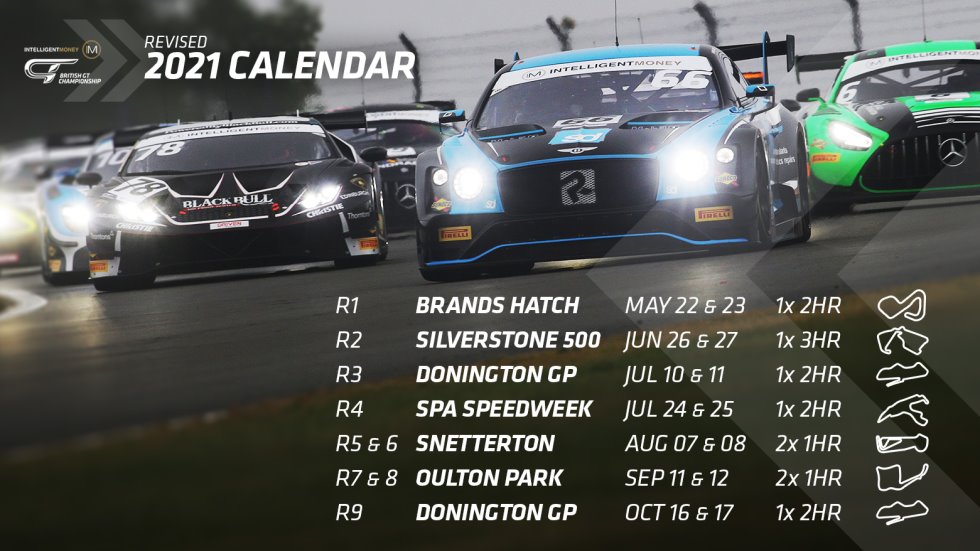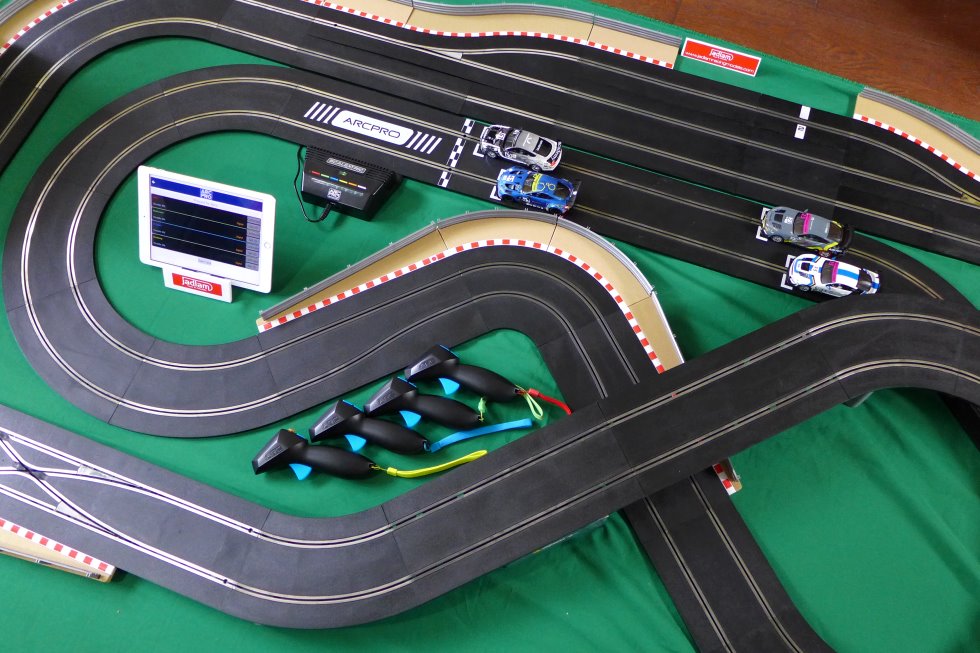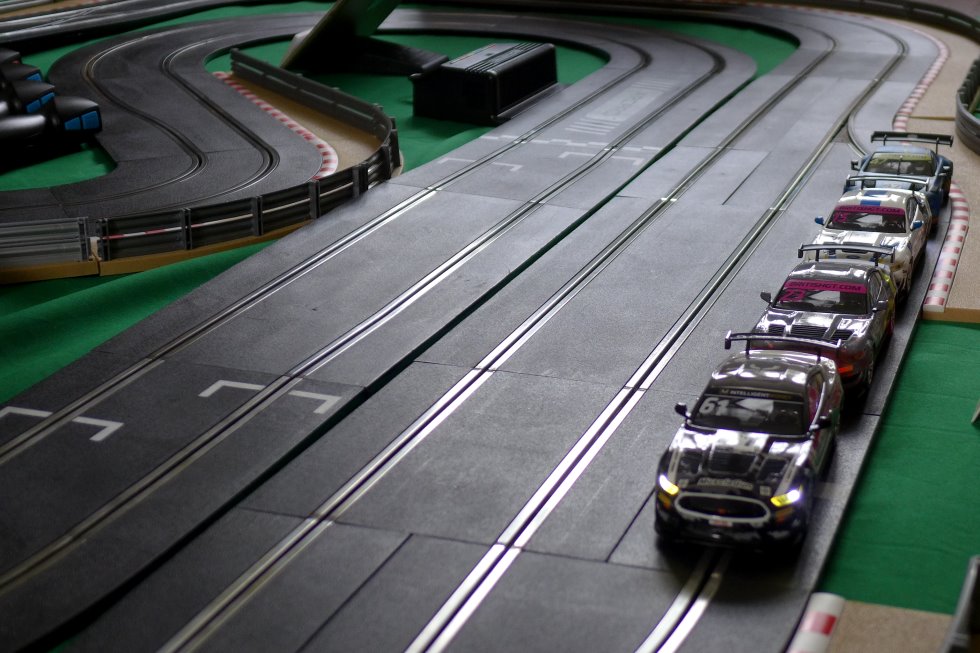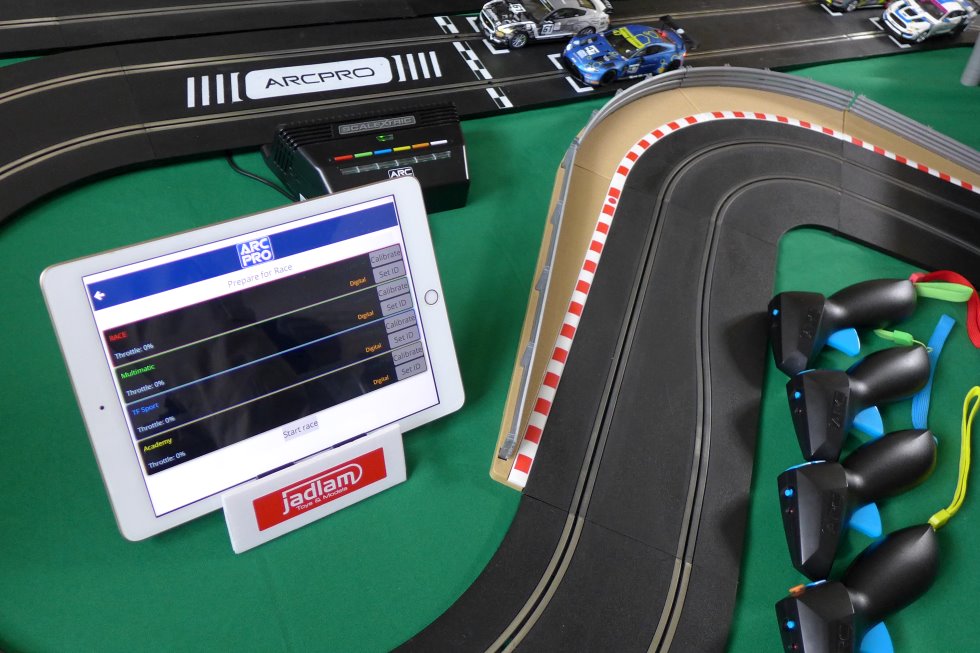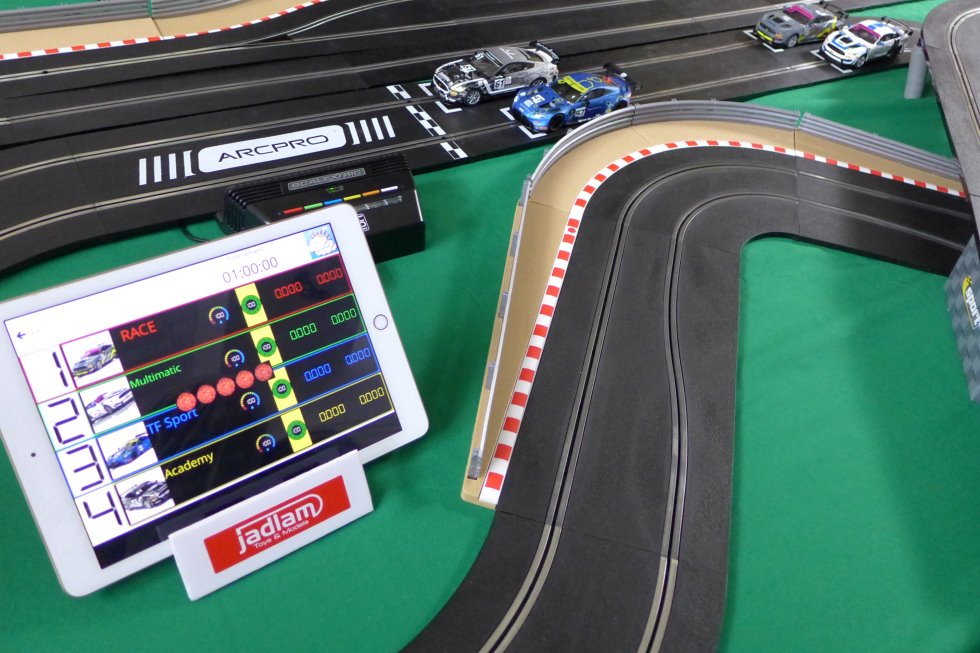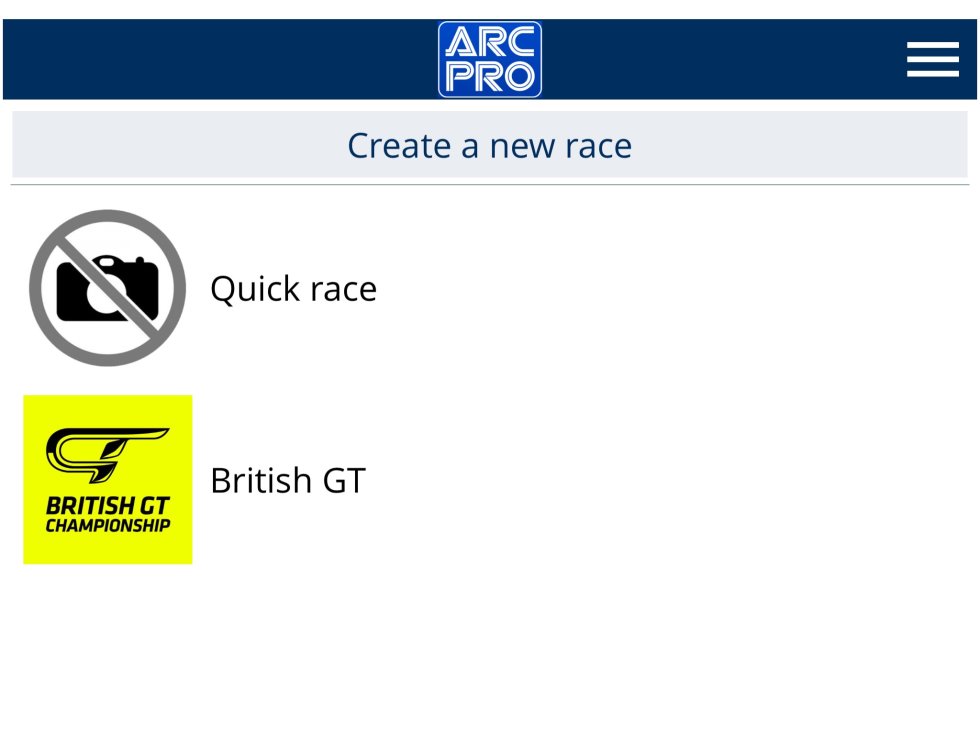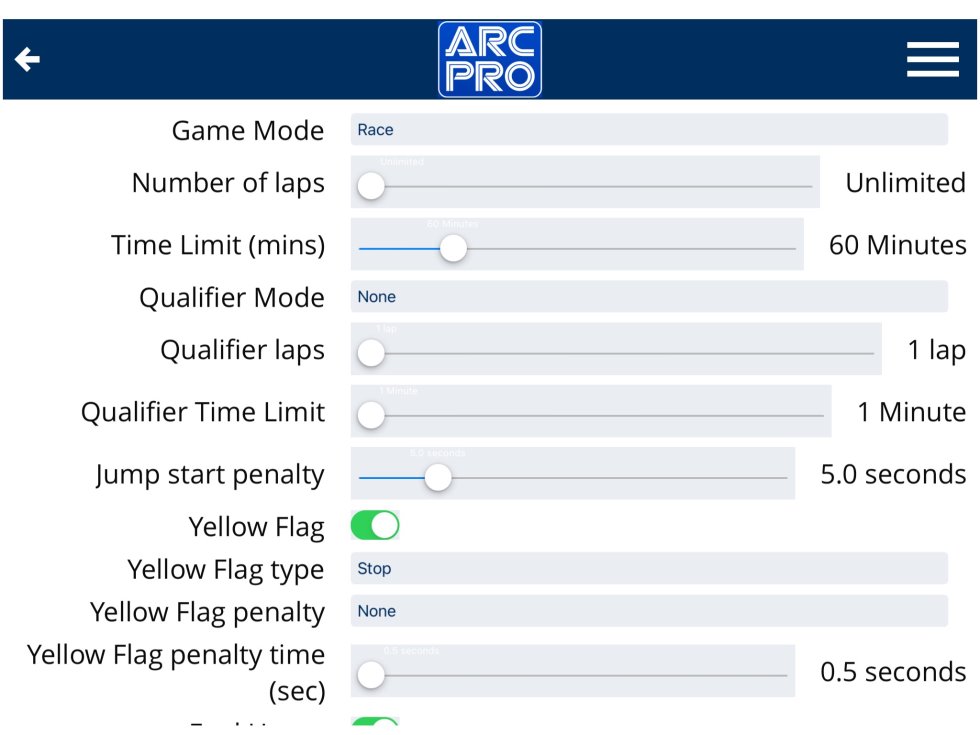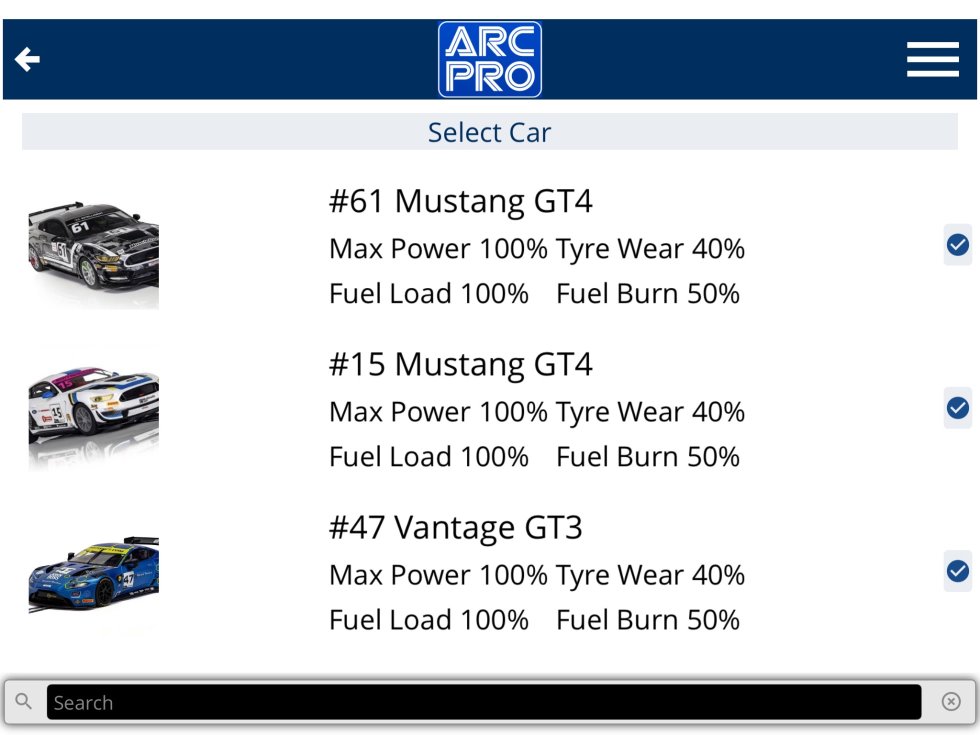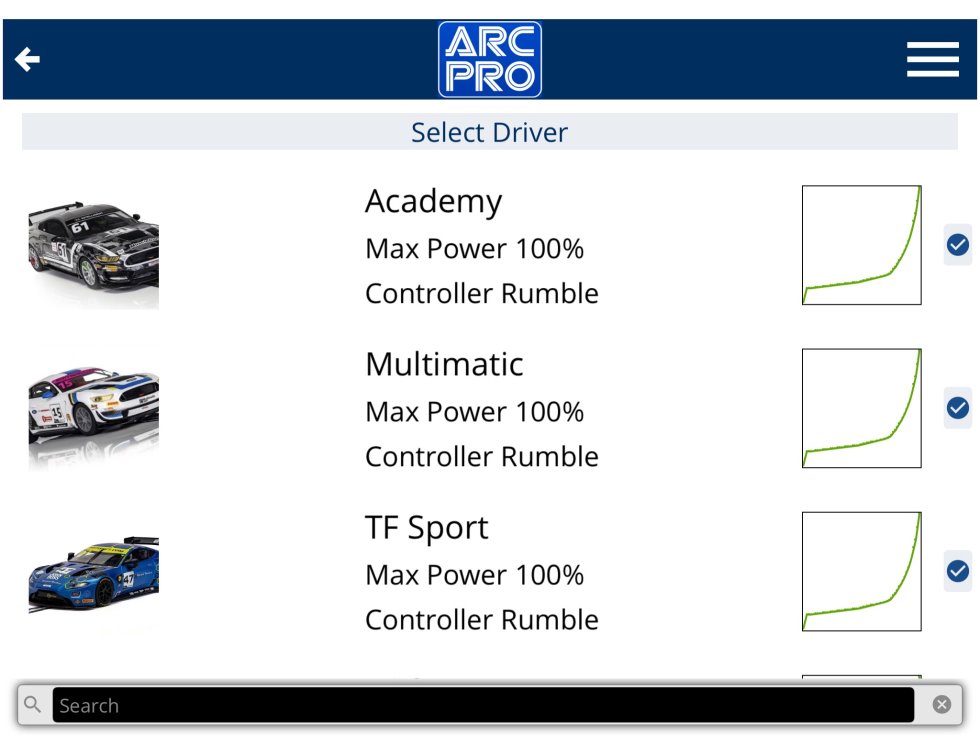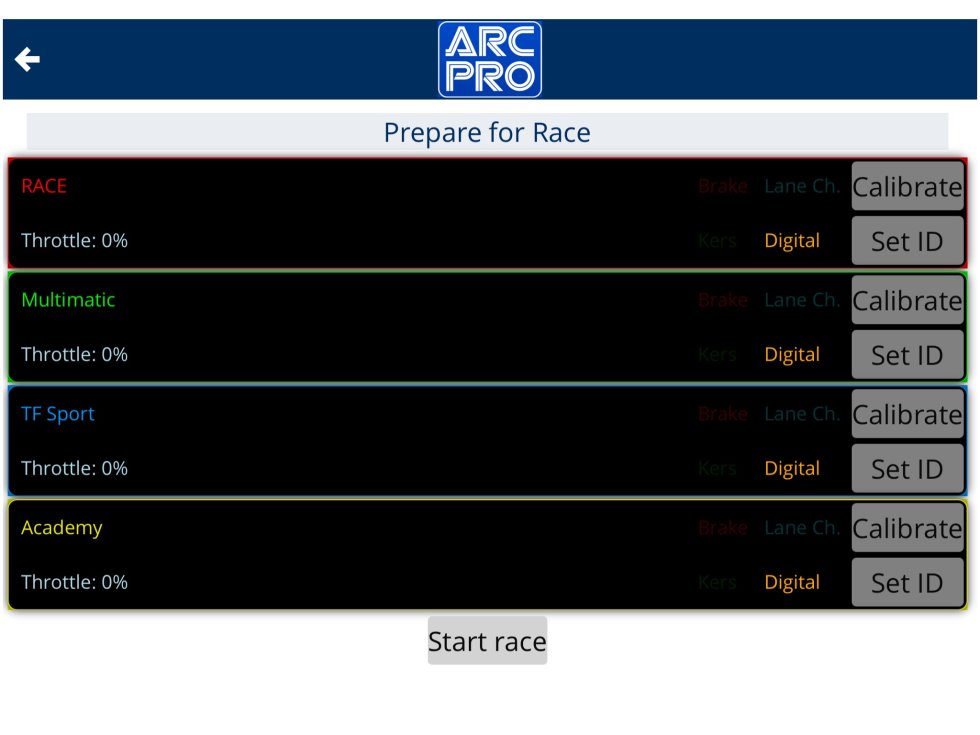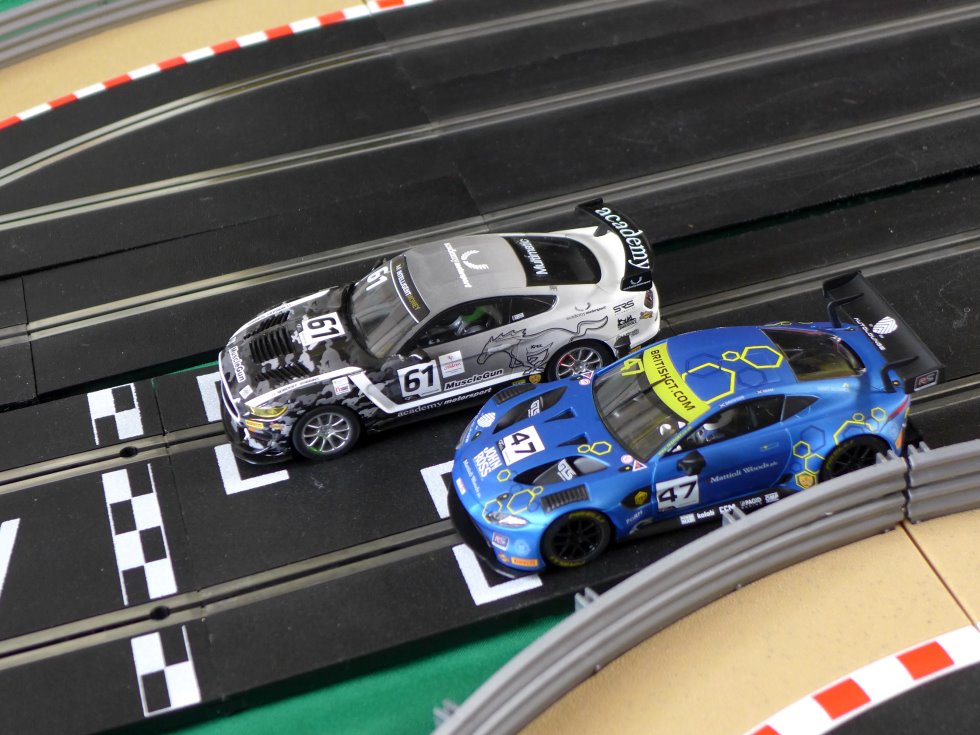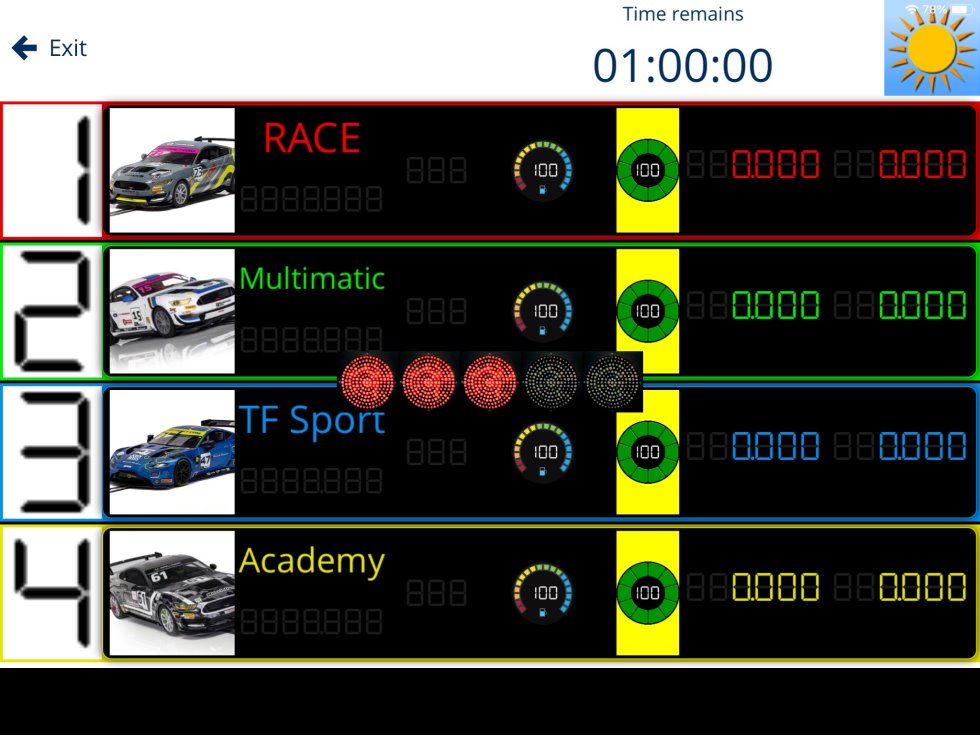Fancy a one-hour team endurance race with up to six cars and twelve drivers?
I really enjoy using ARC Pro to simulate real-life racing formats – and some of my favourite racing is GT racing. The awesome grids of cars, the pit stops, driver changes and races of between one and twenty-four hours are just brilliant to watch. With ARC Pro – and in this case the Magic ARC App – we can easily recreate all that in 1:32 scale.
Last week I chatted to Matt Nicoll-Jones from Academy Motorsport about his Mustang GT4, the team and the British GT Championship. That conversation helped me refine the GT format I’d already put together for club racing at WHO/digital. I’m going to use the Magic App instead of the official Scalextric ARC app, as it will allow us to customise fuel and tyre wear, stretch out the time between pit stops and increase length of the pit stops themselves.
Although I’m going to concentrate on the minutiae of the British GT Championship, this format can easily be tweaked to simulate almost any GT or endurance series.
The British GT Championship
We looked briefly at the Championship last week. To get a proper feel of the series, watching a few full races on YouTube really helps – and there’s a great summary of the format here: www.britishgt.com/about/british-gt
Race length. As you can see from this year’s calendar (above, right), there is a mix of distances. Two-hour races feature at four weekends, plus there’s a three-hour race at Silverstone. The other two weekends are double-headers, with a pair of one-hour races on the Sunday. A Scalextric GT championship should also feature this sort of variety – as the different race lengths require different skills and strategy. The longer endurance events score 50% more points for the championship standings than the one-hour sprint races.
Classes of cars. The start of the 2020 race at Oulton Park (above, left) shows the GT3 cars at the front and the GT4 cars at the back. This mix of classes is one of the things I like about the British GT Championship – great for spectators and for the drivers. In a Scalextric championship, we can tweak the build regulations – or use power settings in the app – to give the GT3 cars better performance. Or we can leave them the same. At the moment, there aren’t too many Scalextric GT4 cars to choose from.
Driver grading. All racing drivers are categorised by the FIA, based on their experience and success. The top drivers in the world – such as those in Formula One – are Platinum; Gold and Silver make up most professional drivers; and Bronze are amateur drivers. The British GT Championship currently has Pro-Am, Silver-Am and Amateur teams in GT3. In GT4, all-Silver driver pairings are still permitted. In a Scalextric championship, pairing the best drivers with less experienced ones is the ideal way to create competitive racing – and replicate the Pro-Am crews that are the backbone of the British GT Championship.
Drive time regulations. In most GT championships, the time each driver is in the car should be fairly equal to their team mate. In British GT one-hour races, there is a driver-change window between 22 minutes and 32 minutes for GT3 and 28-38 minutes for GT4. The difference is to avoid an overcrowded pit lane. For the longer races, it is specified that the starting driver must drive for at least 62 minutes – or 58 minutes in GT4. Although maintaining similar driving times, we can be flexible with our Scalextric championship – not everyone can race for half an hour – or an hour – especially when using the ARC controllers.
Pitstops. All cars in the British GT Championship are restricted to a minimum pitstop time to change driver, refuel and change tyres. The times differ for each circuit, GT4 cars stop for longer and there’s extra for the all-Silver driver pairings. Each car must make at least one pitstop – and in the three-hour races, teams must complete at least three stops.
Success penalties. In the British GT Championship, time is added to the pitstops of the top three finishers from the previous round. In one-hour races, that’s 10, 7 and 5 seconds. For the longer races, it’s 20, 15 and 10. This isn’t the easiest thing to add to a Scalextric race, but there are ways to do it. One option is to start those three cars from the pitlane and delay them leaving – or to give them a Stop-Go penalty during the race. Success penalties add to the fun and the strategy of the championship.
Balance of Performance (BoP). As I mentioned last week, BoP attempts to keep all the cars on a similar performance level – delivering exciting racing and encouraging manufacturers to enter their cars, knowing they are in an equal fight. GT series organisers spend a lot of time analysing data and adjusting BoP. The main techniques they use are weight, engine horsepower and aerodynamics. In a Scalextric GT series using the Magic ARC App, we could use the Max Power setting, although very small adjustments don’t make a whole lot of difference. It could also be a very time-consuming process to get right – and like in real GT racing, car owners and drivers will never be entirely happy!
Control Tyre. Another way to standardise performance is to use a tyre from a single manufacturer. Pirelli currently supply tyres to the British GT Championship and have developed a range of tyres that give similar grip and performance for the various GT3 cars. In GT4 there is a standard wheel and tyre combination. This could be simulated in a Scalextric GT series if all cars use the same tyre – or compound. Mechanical grip from the tyres is super-important when running slot cars without magnets. The newer in-line GT cars can all be fitted with NSR or Slot.it tyres, as I used on the Mustang (see here). One or other of the Slot.it P6 or NSR RTR tyres would be ideal. Unfortunately, the older ‘sidewinder’ cars have different-sized wheels, so that may be a case of changing the wheels to 17.3mm Slot.it plastic wheels, glued to the axle and fitted with suitable wheel inserts.
Scalextric GT Cars
To run these one, two or three-hour races, we’ll need Scalextric cars with the traction magnets removed. Otherwise, we’ll be limited to 10 or 15 minutes before the motor overheats and may become permanently damaged. You can look at how I prepared a non-magnet Mustang GT4 in the Scalextric Tuning series here: blog.jadlamracingmodels.com/2021/07/09/scalextric-tuning-9-removing-the-magnet/
Scalextric have produced some excellent liveries from the British GT Championship over the years – and two new-for-2021 models won their classes at Snetterton during the summer. The Academy Motorsport Ford Mustang GT4 and the RAM Racing Mercedes AMG GT3 Evo are two of the nicest liveries in the Scalextric catalogue. You can buy the Mustang here: www.jadlamracingmodels.com/scalextric-slot-car-c4221-ford-mustang-gt4-academy-motorsport-2020/ and pre-order the Mercedes here: www.jadlamracingmodels.com/scalextric-slot-car-c4242-mercedes-amg-gt3-british-gt-2020-de-haan-kujala/
I’ve chosen to race just four cars on my Jadlam SL6 test track. Any more and it does get rather congested. However, four cars does mean eight drivers – and a lot of fun. Three of the four cars are GT4 Mustangs (I do like them) and the other is the TF Sport Aston Martin Vantage V8. Apart from the Academy Motorsport Mustang, the others all raced in the 2019 British GT Championship. The Multimatic Mustang is still available unboxed: www.jadlamracingmodels.com/scalextric-slot-car-c4173-ford-mustang-gt4-white-car-no-15/.
Also still available is Jonny Adam and Flick Haigh’s 2018 title-winning Aston Martin V12 – www.jadlamracingmodels.com/scalextric-slot-car-c4027-aston-martin-gt3-british-gt-2018-f-haigh-j-adam/. To be honest, any modern GT3 or GT4 car will do – that gives you the choice of the two Aston Martins, Bentley Continental, McLaren MP4 12C, the old-style Mercedes, BMW Z4, Audi R8 LMS, Lotus Evora GT4, Porsche 911 RSR and even the lovely Maserati GranTurismo MC ‘Trofeo’, which was turned into a GT4 racer. I am sure there will be even more in next year’s catalogue.
To race on a Scalextric ARC Pro digital layout, these cars will need to be converted with the C8515 Digital Plug.
Track and Hardware
For pitstops, you need a pit lane – and the pit lane needs to be long enough to hold all the cars racing. I can just about manage that by adding a C7014 left-handed pit lane on the main straight of my Jadlam SL6 track – but I prefer to extend the straight by at least one full C8526 Standard Straight to give some extra room. A couple of packs of C7016 single-lane half straights always come in handy when building a pit lane.
I have also squeezed in two C7036 Digital Lane Changer pieces to allow overtaking – and also for cars to get into the correct lane to reach the pits. I have an ARC Pro powerbase and four ARC controllers. As we’ll be racing for a while, it’s sensible to check (or change) the batteries in the controllers – if the charge runs low during the race, the driver will experience all sorts of odd throttle and brake behaviour.
I’ll need two smart devices – one for the Magic app and the other to run a timer to indicate the start of the driver-change window. A pad of paper and a pen is always useful to have handy.
It’s also good to have a basic toolkit available – cars can break down. During the race, teams might want to pit to clean the rear tyres and improve grip – especially if the track is laid out on the floor.
The Magic ARC App
This is an alternative to the Scalextric ARC app, produced by Italian developer Cristiano Ruisi of Magic Studio. Scalextric released the Bluetooth communication protocols for the ARC powerbases back in 2018 so that third-party developers could create their own apps. So far, Cristiano’s is the only one commercially available. You can find it in the Microsoft Store, GooglePlay, Apple App Store (if it’s not there, check back in a few days) and Amazon appstore. The webpage is here: magicstudio.eu/index.php/games/arcapp
The Magic app works in a similar way to the Scalextric app. It doesn’t have the visuals or the panache, but Cristiano has included many layers of user-definable settings that are lacking in the Scalextric version. It is aimed at the digital slot car enthusiast and is surprisingly easy to use. A pdf User Manual is available from the website and is also bundled with the app. Of course there are glitches, but they don’t take much to work around – and Cristiano has worked hard to fix those bugs via a feedback forum here.
Setting Up a One-Hour GT Race
I’ve spent quite a lot of time experimenting with the Magic ARC App and finding the settings that work on my track. I hope this will serve as a good basis for your own experimentation to fit the GT format to your own track and requirements.
The first thing is to create and name a new race in the main menu. I’ve used the old British GT Championship logo – a bit of a glitchy process to upload, but worth it. Once it’s set up, the GT race remains in the main menu. Some of the settings we’re interested in are the Race menu – important things like the race length, Yellow Flag options, Start Mode, Race End, plus the simulations for Fuel, Tyres, KERS and Weather. Compared to the Scalextric ARC app, all these have more complexity and can be customised quite extensively. The Magic ARC App can only run races up to 5 hours long. If you want a longer race, you’d need to run several ‘segments’ – for example a 24-hour race would be six 4-hour races.
You’ll notice in the two images above, that I’ve chosen not to use the Fuel Load Simulation. This simulates a ‘sluggish’ car with a heavy fuel load. With a short race, this works well, but in this one-hour race, the effect continues too long – and there’s no way to customise the simulation. I prefer not to use it. I have chosen weather – which is great fun. If the weather changes, cars will experience a power drop and inconsistent handling – a driver can choose to stay out or can pit for new tyres to return power and handling to normal. The amount of rain in the race can be set – but exactly when the rain falls is random. Ideally, toss a coin to decide if the Weather simulation is used or not and – if it is – use dice or a random number generator to set the percentage.
Not all the settings are in the Race menu, there’s also plenty in the General Configuration menu. These are shared options for all races and cannot be saved specifically to our British GT race. The first thing to do is choose a voice (that’s a lot of fun) for the text to speech effects – and made sure the Driver Colors match the colours on the powerbase and the controllers. Then there are general settings about the track, lap times and how the drivers (or teams) are displayed on the race screen. However, there are some settings we want for our GT simulation – the longest possible pit stop time (10 seconds) and the ‘Extremely Low’ option for both Fuel Consumption and Tyre Wear. Because of the extremely low settings, I’ve set the Tyre and Fuel Level Warnings to low percentages – to get a timely reminder to pit. Tyres do ‘go off’ and effect handling, so pitting at 15 or 20% is wise – you can leave Fuel Level to a couple of percent before pitting. If either go to zero, the car will not count laps.
The final settings are for the cars and the drivers – or teams in the GT format. Adding the images is a little glitchy, but helpful for the race screen. From these menus, you can set the Max Power, Tyre Wear, Fuel Load and Fuel Burn settings, which work alongside the settings in the General Configuration menu. I’ve tweaked these settings to give a pitstop about every 15 minutes – about enough time for a decent driving stint and just before my hand starts to cramp from using the ARC controller. I can race for 60, 90 or even 120 minutes with a Slot.it SCP3 controller – so that might be a nice upgrade if you’re considering some serious endurance racing with ARC Pro. In the Driver menu, you can choose controller features – rumble is always useful to prompt a pitstop, although not available with the Slot.it controller. I’ve set the Throttle Curve to the soft ‘Profile A’ which is good for non-mag driving. The final ‘Prepare for Race’ screen allows you to calibrate the low speed for each car – and to connect each car to the powerbase using the Set ID button. This bypasses and streamlines the standard car connection process of pushing buttons on the ARC powerbase.
Running the Race
For a look at some of the issues around Scalextric Digital racing, you can read my ARC Pro Digital Driving School post here. There’s a lot to think about in terms of training less experienced drivers, enforcing ‘No Contact’ racing and marshalling crashed cars. First and foremost, Scalextric racing should be fun – but that fun and enjoyment is helped by some basic rules and organisation.
You’ll notice I haven’t used the Qualifier Mode in the race menu. I usually set up and run practice and qualifying sessions separately. The grid order doesn’t matter very much and qualifying isn’t entirely necessary – but it can be rather exciting! With four cars and eight drivers, one of the non-driving team mates acts as the ‘Race Controller’ and the other three non-drivers ‘marshal’ a part of the circuit – that means replacing cars when they crash and calling for a Yellow Flag if there is a problem with the track, barriers or bridge supports. The cars stop under a yellow flag, but the time continues to count down – like a Full Course Yellow. The first job for the Race Controller is to start the race and hold any cars serving a success penalty in the pits. The Race Controller also announces the driver change windows and notes down how long each driver has raced. When it’s their turn to drive, they hand over Race Control duties to their team mate. Likewise with the marshals.
The Magic race screen is nicely laid out – you and your team mate can keep an eye on progress, fastest lap time, how much fuel is left and how far the tyres have worn. I think it works best if the drivers concentrate on driving and the non-driving team mate makes strategy calls – that’s what happens in real GT racing. With pitstops scheduled for approximately 15 minutes, the team can change drivers after 15, 30 and 45 minutes – as long as each driver races for around 30 minutes in total. That gives options – maybe the ‘Am’ does the first and last 15 minutes and the ‘Pro’ driver has a straight 30 minute stint in the middle.
The more you play with the Magic ARC App, the more you can mould its settings to the GT format that suits your track, your cars and the abilities of your racing buddies. Remember – it’s great to simulate a real-life racing series, but there are always some compromises necessary to maximise the fun.
I hope you’ve enjoyed following my thought process of replicating the British GT Championship format with Scalextric ARC Pro and the Magic ARC App. Maybe it will spark your own creativity to come up with your own formats. Let us know how you get on.



